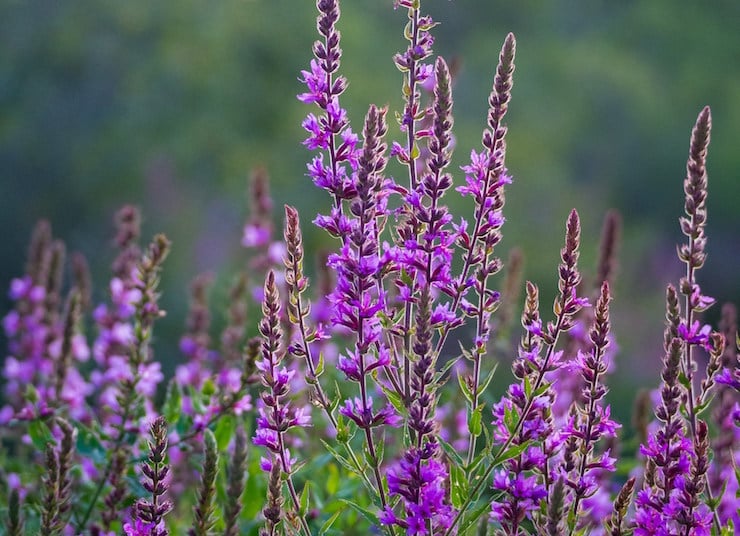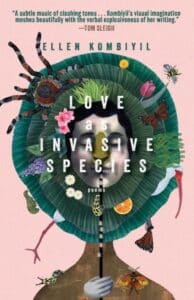About Ellen Kombiyil
Ellen Kombiyil is the author of Histories of the Future Perfect (2015), and a micro chapbook Avalanche Tunnel (2016). Her new book, Love as Invasive Species, was just released by Cornerstone Books. Recent work has appeared or is forthcoming in New Ohio Review, Nimrod, North American Review, and Ploughshares.
She is a 2022 recipient of a BRIO Award (Bronx Recognizes Its Own) from the Bronx Council on the Arts, a two-time winner of the Mary M. Fay Poetry Award from Hunter College, a recipient of an Academy of American Poets college prize, and was awarded the Nancy Dean Medieval Prize for an essay on the acoustic quality of Chaucer’s poetics. A graduate of the University of Chicago and Hunter’s MFA program, she currently teaches writing at Hunter College.
Listen In to Our Chat with Ellen
Tweetspeak (TSP): You have a new collection out called Love as Invasive Species. We’d love to know: where did you get the idea for the title?
Ellen Kombiyil (EK): The title comes from one of the poems in the collection. Yet, the fact that this title works for the collection as a whole is not altogether surprising, as the poems are interlinked, and many poems share a title.
The book traces learned inheritances down my matrilineal line and asks the question, How do we learn to love? Formatted as a tête-bêche or “double book,”—like a vinyl album, you flip the book over and read in towards the center, where a double/mirror poem meets—the poems in Side A and Side B mirror and respond to each other in list order. The book tells a narrative of repetition and repeated patterns, and conceptually bears this out in the book-as-art-object design.
TSP: Regarding that new collection, Tom Sleigh has described the work as a “subtle music of clashing tones.” That’s such an unusual way to describe a collection! How would you put your own meaning to Tom’s words?
EK: Well, thank you to Tom! He wrote such a beautiful blurb and he was also instrumental as a mentor as I was writing the poems in this book. I will say that the poems are best experienced when read aloud, that I pay a lot of attention to the music of the words and to cadence and meter. The clashing tones speak to me of the difficulty reassembling “truth”, of palimpsest—of memory, accuracy, the way images overlap and combine to tell parts of the story. Many of the images are simultaneously beautiful and also very disturbing.
TSP: Tell us about your journey with poetry. Did you always write poems? Or did you find your way to poetry in adulthood? What brought you? What kept you?
EK: I gravitated to poetry very young. The first poem I wrote I remember very clearly walking home from school in 2nd or 3rd grade, and the rhythm of my walking matched the words forming in my head—the meter! When I got home I ran in to find a pencil and write it down. I’ve been writing poems ever since.
TSP: We’re curious to hear how the Bronx (did you grow up there?) has influenced your poetic sensibilities.
EK: I am a Bronx transplant, having moved to the borough in 2016. I grew up in Syracuse, NY, studied in Chicago, lived also in Brooklyn and Manhattan for many years, and lived abroad in India for about 11 years. All of these places have influenced my thinking, my worldview, my cadences of speech, and of course, my experiences of friendship, home, and longing.
TSP: You also do wonderful mixed media collage. How did you get started with that? Do you view it as part of your poetic core? And, do you ever use your art to jumpstart your poems, or vice versa?
EK: Thank you for this question! I was always also an artist from childhood and through college. I continued to take a few art classes in NYC after college, but fell away from art for several decades as I got busier with work and raising a family. I had to re-learn techniques, materials—all of it!—and was happily thrust back into making art during the pandemic. It was such a salve to be a beginner at something again—to truly have ‘beginner’s mind’ and just be in the pure act of making. I owe a lot to Sarah J. Sloat and her book Hotel Almighty, which rekindled the possibility of combining poetry and art.
It was such a salve to be a beginner at something again—to truly have ‘beginner’s mind’ and just be in the pure act of making.
TSP: If you were to give one tip to a blocked poet, what would it be?
EK: Set a timer and make something for 10 minutes. Maybe you write for 10 minutes—I’m a big follower of Natalie Goldberg and her freewriting method in Writing Down the Bones. Or make a 10 minute collage with found items. Or sketch for 10 minutes straight. It doesn’t matter. Tap into your making brain to keep it limber. Eventually you will un-block and have a body of fragments that can get you started.
TSP: Anything new on the horizon for you after Love as Invasive Species? If you’re not yet ready to think about that, tell us some of your launch plans for the collection. (Or tell us both 🙂 )
EK: Oh, yes! I am deep at work at a new collection that combines art, collage, and poetry. The working title for the project is, “Our Prayer a Slit Throat: Erasing the Inheritance of War”, which is just as large as it sounds. I am “erasing war”, beginning with the Western canon, that I erase, collage, and juxtapose in order to reveal the psychic weight of this inheritance.
These particular pieces deconstruct and reassemble both text and image from the following sources:
LIFE magazine (November 16, 1942)
The ROTC Manual, Freshmen Course, First Year Basic (1921)
Guidebook for Marines (1957)
NYPL Digital Collection
Surreal in nature, at times bordering on abstraction, the juxtaposed pieces beg the viewer to make sense of given cultural cues. By engaging with the project, the viewer must assess the meaning of cultural artifacts. What is the nature of the “made” of object? Of fact itself? And what does it mean to make new artifacts through this same process of art/making? How has the text been manipulated? And maybe most importantly, what knowledge do we inherit through texts, and how are (can) texts (be) updated/understood/assessed in different cultural moments.
Thank you so much for these thoughtful questions!
Photo by Shannon Kunkle, Creative Commons, via Unsplash.
Read our review of Love as Invasive Species
- Poetry Club Tea Date ✨ The Turning - September 29, 2025
- Top 10 Dip into Poetry - August 13, 2025
- Poetry Club Tea Date ✨ At the End - August 4, 2025


Leave a Reply